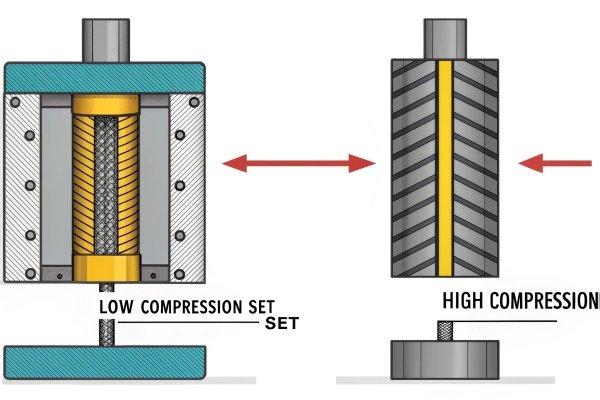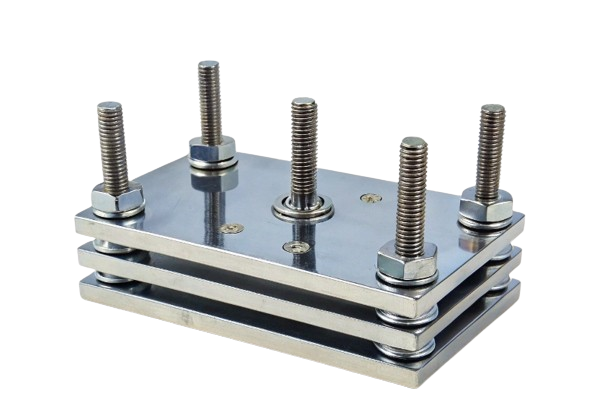Compression set is a key performance characteristic of rubber products that determines how well rubber maintains its shape under prolonged compression. Understanding this concept is vital for selecting the right material for sealing applications.
Compression set is the amount of deformation a rubber part experiences after being compressed for a set period. It indicates how much a rubber material will rebound after compression, which is crucial for its long-term performance in sealing, gaskets, and other applications.
Compression set can make or break the durability of rubber components, so it's essential to understand how it impacts your products.
What is the meaning of compression set?
Compression set refers to the permanent deformation that occurs in rubber materials when they are subjected to prolonged pressure. Over time, when rubber parts are compressed, they lose some of their original shape or volume. This can affect their ability to seal properly.
Compression set is defined as the amount of deformation remaining in a rubber material after it has been compressed for a specific time. The lower the compression set, the better the rubber can recover its original shape.
The compression set test involves compressing a rubber sample for a set period at a specific temperature. The sample is then measured to see how much permanent deformation it retains. The lower the percentage, the better the rubber's resistance to deformation.
Why Compression Set Matters for Sealing Products?
Compression set is particularly important in sealing applications because it affects the material's ability to maintain an effective seal. If the material deforms too much, it may no longer provide a tight seal, leading to leaks and failures in your systems.
Compression Set and Its Impact on Rubber Durability
Over time, a high compression set will lead to rubber products becoming less effective. This is especially critical in industries like HVAC, automotive, and fluid handling, where seals need to maintain performance under pressure.
How to measure compression set?
To measure compression set, a standard procedure involves compressing the rubber sample to a specified percentage of its original thickness. After a set time, the deformation is measured and expressed as a percentage of the original thickness.
The compression set test helps determine how well rubber returns to its original shape after being compressed. This measurement is vital for ensuring that rubber components can perform as required without excessive wear or loss of functionality.
Compression set is usually measured according to ASTM D3951 or similar standards. The rubber sample is compressed at a specified temperature for a set period. The difference between the original and the compressed thickness gives the percentage of compression set.
Common Methods to Conduct Compression Set Tests
- Compression Set Test (ASTM D395): A sample is compressed at a specified temperature for 22 hours, and the deformation is measured.
- Permanent Deformation Test (ISO 815): This test measures the deformation of rubber after compression over 24 hours.
What is the ISO standard for compression set?
The ISO standard for compression set is ISO 8152, which specifies the procedure for determining the compression set of elastomers. This standard is widely used to ensure that rubber products meet the required performance criteria in various industries.
ISO 815 outlines the conditions for testing rubber under compression, such as temperature, duration, and measurement of permanent deformation. Adhering to this standard helps manufacturers guarantee their products will perform well in real-world applications.
ISO 8152 provides a more detailed approach for measuring compression set under various conditions. This includes differences in temperature and compression times that reflect the actual working environment of the rubber material.
Why ISO 815 is Important for Rubber Testing?
By following ISO standards, companies can ensure their rubber products are consistent and reliable. This is crucial for industries like HVAC, automotive, and manufacturing, where product quality and performance are critical.
What is the best rubber for compression set?
When looking for the best rubber material for low compression set, fluoroelastomers (FKM) and silicone rubber are often top choices. These materials exhibit excellent resistance to compression set, making them ideal for sealing and gasket applications.
The best rubber for compression set depends on the specific application and environmental conditions. For instance, silicone rubber is highly resistant to compression set at high temperatures, while nitrile rubber is preferred in oil-resistant applications.

"Compression set measure rubber’s ability to return to its original shape after being compressed"
Choosing the right rubber involves balancing compression set resistance with other material properties like temperature resistance, chemical compatibility, and flexibility. For example, while silicone has great compression set resistance, it may not perform well in oil or chemical environments.
Rubber Materials Known for Low Compression Set
- Fluoroelastomers (FKM): Excellent for high-temperature and chemical-resistant seals.
- Silicone Rubber: Ideal for extreme temperatures but not resistant to oils.
- Nitrile Rubber: Best for oil-resistant applications, but may not have the lowest compression set.
Conclusion
Understanding compression set is crucial when selecting the right rubber material for your sealing needs. By measuring and comparing the compression set, you can ensure long-lasting performance in your rubber products.
-
ASTM D395 is a widely used standard test method for measuring compression set in rubber materials. It defines the procedure for compressing a sample of rubber to determine how much permanent deformation remains after compression. ↩
-
ISO 815 is the international standard for measuring the compression set of elastomers. It outlines test procedures to ensure rubber products meet performance expectations under compression. ↩ ↩









